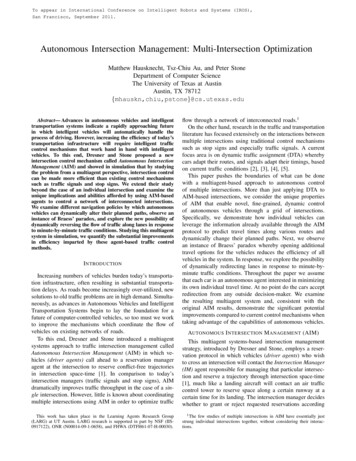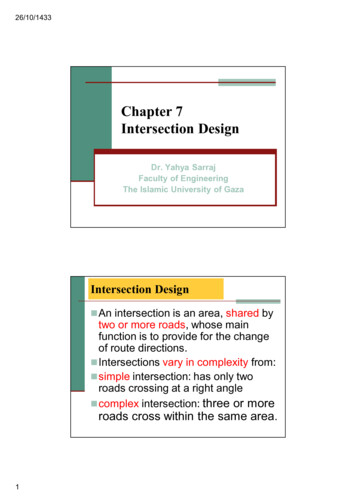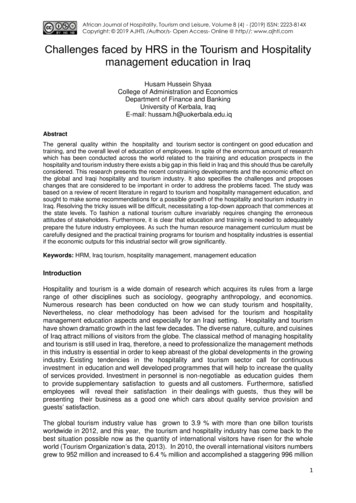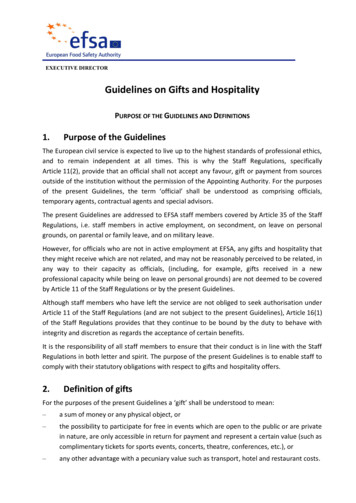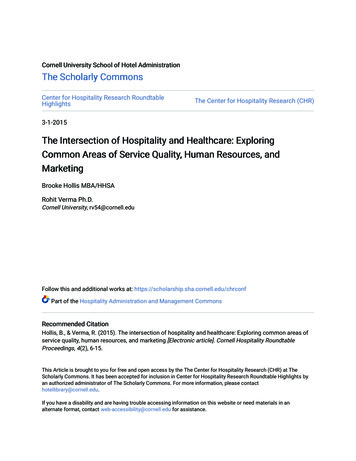
Transcription
Cornell University School of Hotel AdministrationThe Scholarly CommonsCenter for Hospitality Research RoundtableHighlightsThe Center for Hospitality Research (CHR)3-1-2015The Intersection of Hospitality and Healthcare: ExploringCommon Areas of Service Quality, Human Resources, andMarketingBrooke Hollis MBA/HHSARohit Verma Ph.D.Cornell University, rv54@cornell.eduFollow this and additional works at: https://scholarship.sha.cornell.edu/chrconfPart of the Hospitality Administration and Management CommonsRecommended CitationHollis, B., & Verma, R. (2015). The intersection of hospitality and healthcare: Exploring common areas ofservice quality, human resources, and marketing [Electronic article]. Cornell Hospitality RoundtableProceedings, 4(2), 6-15.This Article is brought to you for free and open access by the The Center for Hospitality Research (CHR) at TheScholarly Commons. It has been accepted for inclusion in Center for Hospitality Research Roundtable Highlights byan authorized administrator of The Scholarly Commons. For more information, please contacthotellibrary@cornell.edu.If you have a disability and are having trouble accessing information on this website or need materials in analternate format, contact web-accessibility@cornell.edu for assistance.
The Intersection of Hospitality and Healthcare: Exploring Common Areas ofService Quality, Human Resources, and MarketingAbstractWithin the context of providing high quality clinical outcomes, managers in the U.S. healthcare system areworking hard to solve several problems, including the challenging and interrelated problems of how tocontrol operating costs, how to improve employee retention, and how to satisfy customers andstakeholders. Beyond that, the industry faces substantial capital expenses when constructing newfacilities and renovating or maintaining existing aging structures. In short, many of the issues facing thehealthcare system are similar to those of the hospitality industry.KeywordsCornell, hospitality industry, sustainability, greenDisciplinesHospitality Administration and ManagementCommentsRequired Publisher Statement Cornell University. This report may not be reproduced or distributed without the express permission ofthe publisher.This article is available at The Scholarly Commons: https://scholarship.sha.cornell.edu/chrconf/14
The Center for Hospitality ResearchHospitality Leadership Through LearningThe Intersection of Hospitalityand Healthcare:Exploring Common Areas of Service Quality,Human Resources, and MarketingCornell Hospitality ProceedingsVol. 4 No. 2, March 201202th1992 - 2012by Brooke Hollis, M.B.A., and Rohit Verma, Ph.D.ANNIVERSARYCornell UniversityCollege of Human EcologySloan Program in Health Administration
Advisory BoardNiklas Andréen, Group Vice President Global Hospitality &Partner Marketing, Travelport GDSRa’anan Ben-Zur, Chief Executive Officer, French QuarterHoldings, Inc.Scott Berman, Principal, Real Estate Business AdvisoryServices, Industry Leader, Hospitality & Leisure,PricewaterhouseCoopersRaymond Bickson, Managing Director and Chief ExecutiveOfficer, Taj Group of Hotels, Resorts, and PalacesStephen C. Brandman, Co-Owner, Thompson HotelsRaj Chandnani, Vice President, Director of Strategy, WATGEric Danziger, President & CEO, Wyndham Hotel GroupBenjamin J. “Patrick” Denihan, Chief Executive Officer,Denihan Hospitality GroupChuck Floyd, Chief Operating Officer–North America,HyattRJ Friedlander, CEO, ReviewProGregg Gilman, Partner, Co-Chair, Employment Practices,Davis & Gilbert LLPTim Gordon, Senior Vice President, Hotels, priceline.comSusan Helstab, EVP Corporate Marketing,Four Seasons Hotels and ResortsPaul Hineman, Executive Director, National RestaurantAssociationSteve Hood, Senior Vice President of Research, STRJeffrey A. Horwitz, Chair, Lodging Gaming, and Head ofPrivate Equity Real Estate, ProskauerKevin J. Jacobs, Senior Vice President, Corporate Strategy &Treasurer, Hilton WorldwideKenneth Kahn, President/Owner, LRP PublicationsKeith Kefgen, Chief Executive Officer, HVS Executive SearchKirk Kinsell, President, The Americas, InterContinental HotelsGroupRadhika Kulkarni, Ph.D., VP of Advanced Analytics R&D,SAS InstituteGerald Lawless, Executive Chairman, Jumeirah GroupSteve Levigne, Vice President, U.S. Strategy & Insights,McDonald’s CorporationMark V. Lomanno Executive Board Member,newBrandAnalyticsDavid Meltzer, Chief Commercial Officer, Sabre HospitalitySolutionsWilliam F. Minnock III, Senior Vice President, GlobalOperations Deployment and Program Management,Marriott International, Inc.Mike Montanari, VP, Strategic Accounts, Sales - SalesManagement, Schneider Electric North AmericaShane O’Flaherty, President, International and Ratings, ForbesTravel GuideChris Proulx, CEO, eCornell & Executive EducationCyril Ranque, SVP, Global Market Management, Expedia,Inc.Carolyn D. Richmond, Partner, Hospitality Practice, FoxRothschild LLPSusan Robertson, CAE, EVP of ASAE (501(c)6) & President ofthe ASAE Foundation (501(c)3), ASAE FoundationMichele Sarkisian, Senior Vice President, MaritzJanice L. Schnabel, Managing Director and Gaming PracticeLeader, Marsh’s Hospitality and Gaming PracticeTrip Schneck, Managing Partner, District Hospitality PartnersK. Vijayaraghavan, Chief Executive, Sathguru ManagementConsultants (P) Ltd.Adam Weissenberg, Travel, Hospitality & Leisure practiceLeader, Deloitte & Touche USA LLPThe Robert A. and Jan M. Beck Center at Cornell UniversityCornell Hospitality Proceedings,Vol. 4, No. 2 (March 2012) 2012 Cornell University. This report maynot be reproduced or distributed withoutthe express permission of the publisher.Cornell Hospitality Report is produced forthe benefit of the hospitality industry byThe Center for Hospitality Research atCornell UniversityRohit Verma, Executive DirectorJennifer Macera, Associate DirectorGlenn Withiam, Director of PublicationsCenter for Hospitality ResearchCornell UniversitySchool of Hotel Administration489 Statler HallIthaca, NY 14853Phone: 607-255-9780Fax: 607-254-2922www.chr.cornell.edu
Thank you to our generous Corporate MembersSenior PartnersASAE FoundationCarlson HotelsHilton WorldwideNational Restaurant AssociationSASSTRTaj Hotels Resorts and PalacesPartnersDavis & Gilbert LLPDeloitte & Touche USA LLPDenihan Hospitality GroupeCornell & Executive EducationExpedia, Inc.Forbes Travel GuideFour Seasons Hotels and ResortsFox Rothschild LLPFrench Quarter Holdings, Inc.HVSHyattInterContinental Hotels GroupJumeirah GroupLRP PublicationsMaritzMarriott International, Inc.Marsh’s Hospitality PracticeMcDonald’s opersProskauerReviewProSabre Hospitality SolutionsSathguru Management Consultants (P) Ltd.Schneider ElectricThayer Lodging GroupThompson HotelsTravelportWATGWyndham Hotel GroupFriends4Hoteliers.com Berkshire Healthcare Center for Advanced Retail Technology Cleverdis CompleteSeating Cruise Industry News DK Shifflet & Associates ehotelier.com EyeforTravel Gerencia deHoteles & Restaurantes Global Hospitality Resources Hospitality Financial and Technological Professionals hospitalityInside.com hospitalitynet.org Hospitality Technology Magazine HotelExecutive.com InternationalCHRIE International Hotel Conference International Society of Hospitality Consultants iPerceptions JDASoftware Group, Inc. J.D. Power and Associates The Lodging Conference Lodging Hospitality LodgingMagazine LRA Worldwide, Inc. Milestone Internet Marketing MindFolio Mindshare Technologies PhoCusWright Inc. PKF Hospitality Research Questex Hospitality Group Resort and Recreation Magazine The Resort Trades RestaurantEdge.com Shibata Publishing Co. Synovate UniFocus Vantage Strategy WageWatch, Inc. The Wall Street Journal WIWIH.COM
The Intersectionof Hospitality andHealthcare:Exploring Common Areas of Service Quality,Human Resources, and Marketingby Brooke Hollis and Rohit VermaAbout the AuthorsBrooke Hollis, MBA/HHSA, MArch&UD serves on the leadership team of the Sloan Program in HealthAdministration. In addition to his work with alumni and industry, he mentors students, and serves as afaculty member. Beyond his appointment at Sloan, his ongoing professional consulting activities straddle thearea of mergers and acquisitions and management consulting primarily for health and professional servicesfirms. His background includes over three decades working in both the public and private sector, serving insenior management positions in a number of organizations in the health and financial services fields. Whileserving as president of a national professional association, he was involved in advocacy work with the federalgovernment on policy and financial issues. For almost a decade he was a partner and president of a privatefirm that developed and managed specialty outpatient clinics, ran a durable medical equipment companyand provided contract staffing programs for hospitals in three states. His workas a partner in mergers & acquisitions advisory firms has involved consulting and transaction advisory work in20 states and Canada with private equity funds, and both public or privately held domestic and internationalcompanies.Rohit Verma, Ph.D., is professor of operations management and executive director of the Center forHospitality Research at the Cornell University School of Hotel Administration (rohit.verma@cornell.edu). Amonghis research interests are product-and-service design and innovation, customer choice modeling, and qualityprocess improvement of supplier selection strategies. His work has appeared in such publications as MIT SloanManagement Review, Journal of Operations Management, and Cornell Hospitality Quarterly.4The Center for Hospitality Research Cornell University
Executive SummaryHeld in fall 2011, the first Hospitality and Healthcare Roundtable represented a collaborationbetween the Center for Hospitality Research and the Sloan Program in Health Administrationat Cornell University. While space limitations cannot fully capture the depth of discussion during theroundtable, these proceedings attempt to capture some of the ideas discussed and developed duringthe program. Nearly three dozen participants from both industries shared their best practices, with the goal offinding common ground and cross-pollinating towards the development of improved strategies.Beyond the many intersections of the two fields noted in the body of the proceedings, a recurring theme for theroundtable was the idea that success in both healthcare and hospitality depends on the core principle of creating aculture of respectful treatment and valuing all stakeholders. An effective culture engages staff members and ensuresthat they feel their work is important and appreciated. At the same time, effective operations depend on continualand careful measurement of customer satisfaction, using such rubrics as net promoter scores and the nationalHospital Consumer Assessment of Healthcare Providers and Systems (HCAHPS).A particular challenge for many healthcare systems involves aged facilities, particularly those located in innercities. While the facility itself may largely be inflexible, the staff ’s approach can help overcome that negative factor.Other small touches also help, such as making sure the facility is sparkling clean, uncluttered, nicely decorated,and properly lighted. Food service is a critical part of patient satisfaction in facilities of all kinds. Many hospitalsare moving to a catering-style approach that brings food to patients when they need it. Senior care and continuingretirement care facilities expressly use hospitality-type approaches, with guests who are long-term rather thantransient. As is true of many segments of the healthcare industry, the customer for senior living facilities is not onlythe client but also the client’s family. Thus, a holistic approach is needed that involves resident and family alike.The healthcare system faces financial challenges, as it is likely that hospitals in particular will see reducedpayment levels. For this reason, healthcare systems must pay particular attention to costs and find ways to applyinnovative ideas from hospitality and other areas to reduce inefficiencies while maintaining high quality outcomes.For society as a whole, the greatest cost savings may be to help people stay healthy, and many healthcare systemsare encouraging behavior that prevents or delays illness, often borrowing ideas from the hospitality industry.Finally, the flow of expertise between the two industries can run in both directions. While healthcare isbenefitting from a hospitality-style approach of focusing on a service culture, the hospitality industry can learnfrom healthcare’s expertise in complex-system management, which involves a system with many moving parts,some of which are independent of each other, the presence of numerous intertwined legal, human resource, andsupply chain subsystems, working with multiple decision makers and stakeholders, and a collaborative approachto product and service innovation.Cornell Hospitality Proceedings March 2012 www.chr.cornell.edu5
COrnell Hospitality ProceedingsThe Intersection ofHospitality and Healthcare:Exploring Common Areas of Service Quality,Human Resources, and Marketingby Brooke Hollis and Rohit VermaWithin the context of providing high quality clinical outcomes, managers in theU.S. healthcare system are working hard to solve several problems, including thechallenging and interrelated problems of how to control operating costs, how toimprove employee retention, and how to satisfy customers and stakeholders.Beyond that, the industry faces substantial capital expenses when constructing new facilities andrenovating or maintaining existing aging structures. In short, many of the issues facing the healthcaresystem are similar to those of the hospitality industry.6The Center for Hospitality Research Cornell University
Beyond these operational and capital planning issues, theintersections between the fields of hospitality and healthcarecontinue to expand. The many areas of overlap call for innovative thinking in both industries as they share their bestpractices. Areas of common interest include medical traveland tourism; hotels as transitional care partners and, moretraditionally, as places for visiting family members; the recruiting of leaders with hospitality backgrounds by healthcareorganizations; the exploding growth of the heavily hospitality-oriented senior living and care industry; working to meetMedicare’s new HCAHPS performance criteria; increasedfocus on the measurement of patient and staff satisfaction;recognition of the need to better manage the “hotel functions”of hospitals and other care facilities; services outsourced byhealthcare organizations to hospitality companies; a changing paradigm where families are now “guests,” with stay-overfacilities designed into patient rooms; the growth of complementary and alternative medical spas—some with affiliationswith groups like the Cleveland Clinic; hospitals contractingwith hospitality-oriented companies for service excellenceand leadership training (e.g., Ritz-Carlton, Four Seasons, andDisney); increased interest in evidence-based design researchand hiring of hospitality consultants in planning new healthcare facilities; and the growth of new models that incorporate hospitality ideas in creating a more patient and familycentered environment (e.g., like Planetree ).Pointing out the importance of cross-pollination between the two industries, Professor Rohit Verma, roundtableco-chair presented some of the principles that hospitalityexecutives can learn from the healthcare industry. Althoughhospitality operations have their own levels of intricacy, theoperating issues that face healthcare operators are even morecomplex. Healthcare systems involve multiple decision makers and numerous stakeholders, including physicians whooften are not employees. They also have many moving parts—some of which are interdependent and others of which areonly partially so. Healthcare’s numerous sub-systems arelikewise complicated, as they involve legal, revenue, humanresources, and supply-chain issues. While hotels must havedisaster plans, healthcare systems are at the nexus of anydisaster and must carefully manage critical processes. Inshort, healthcare is a high stress environment. At the sametime, healthcare involves a collaborative product much likehospitality and is also focused on service innovation in themidst of this complexity.Cornell Hospitality Proceedings March 2012 www.chr.cornell.eduThus, hospitality and healthcare have many challengesand concerns in common, but the healthcare industryis ground zero for political policy making, unlike thehospitality industry, and interactions with the healthcaresystem excite greater emotion among all stakeholders thanthose typically found in hospitality. As explained in thisProceedings, perhaps the most critical management strategyapplied by the healthcare industry is to instill a culture ofservice. Coupled with a fact-based approach that sets goalsand constantly measures results in all areas, healthcaresystems can manage their inherent intricacy. Benchmarksare set by managers and also by regulators and otherstakeholders, reinforcing the complexity of the manager’sjob. Thus, although healing patients remains job one—it isno longer sufficient merely to heal the patient. Surroundingthat critical goal is meeting the needs of family membersand care givers, while controlling costs and meeting appropriate standards. A complex business, indeed.Opening Keynote Speech:Applications of Hospitality Techniques HelpDrive Hospital Performance and CultureIn his opening remarks, Gerard van Grinsven, presidentand CEO of Henry Ford West Bloomfield Hospital, WestBloomfield, Michigan, explained that patient satisfaction isa result of a philosophy that is embedded in the culture—aphilosophy that also extends to employee retention andgrowth. Formerly a vice president with the Ritz-CarltonCompany, van Grinsven noted that people were surprisedwhen a hotelier was appointed as head of a healthcare system. He pointed out, however, that given the two industries’common issues, embedding the Ritz-Carlton philosophy ofengaging stakeholders was the key to creating a successfulculture. Although the Michigan facility was newly opened,he explained how this approach can be effective in any facility. It is not a matter of offering luxury or having fine facilities but is instead a matter of embedding the culture. Infact, while the West Bloomfield facility is quite nice, it wasdesigned to be a comfortable patient- and family-friendlyenvironment—and not a luxury hotel-type facility.These efforts are not limited to West Bloomfield—thishospital is part of the larger Henry Ford Health System(HFHS), which has a system-wide commitment to qualityand improvement. CEO Nancy Shlichting specifically selected van Grinsven because he could supply ideas that she7
Gerard van Grinsven: Patient satisfaction is the result of a philosophy that isembedded in the hospital’s culture—and not just because of a modern facility.felt could be applied to their entire system. It appears thatsome of these ideas have helped, as HFHS was recently recognized as one of only four 2011 recipients of the MalcolmBaldrige National Quality Award.Building CultureTo build a culture of success in employees, van Grinsvenstarts by recruiting talented people who will fit the operationand then invests in them to encourage their growth in thejob. In this regard, van Grinsven distinguishes between talent and skill sets. People who have the talent to be naturallycaring about people can establish relationships with clientsregardless of their initial skill set. To identify people withthese traits, HFHS has adapted the approaches used at RitzCarlton to screen all applicants—including medical staff.Once a manager has confirmed that a person will fitwell with the organization, it’s critical to help that persongrow in the position. This takes investment in employees,and coaching them on talents that they have (rather thantrying to give them skills that they don’t have). Van Grinsvenpointed to a failure to invest in employees as a major driverfor staff turnover. As he expressed this staff-developmentformula: Talent Fit x Investment Growth. Additionally,this approach of encouraging growth in employees simplifiesthe management model. Too often, he said, he sees systemsas being so complicated that they are difficult to control.With a priority of staff growth and a cultural focus,he has seen that a healthcare system will achieve its goals,regardless of the nature of the facility—because employeeswill be engaged and turnover will diminish. For this reason,HFHS applies employee engagement as a measure of success.Standing in the way of this success may be a certain percent-8Rob MacKenzie: It’s important to make bothpatients and employees feel that they are valued.For employees, monetary incentives are helpful.age of employees who are actively disengaged. Some aredisengaged because their unspoken needs are not met, andsome are truly just working for a paycheck. Needless to say,it’s important to determine which employees are which. VanGrinsven said that about 30 percent of employees typicallyare engaged in their job, and another 50 percent are notengaged but are also not disengaged. They do their job butdon’t extend themselves. To engage these employees, managers must identify those workers’ unexpressed needs. For the20 percent that are actively disengaged, about half can beengaged, again by working with their needs. The remaining10 percent probably need to find work elsewhere.Value-Focused ImprovementPresenting a case study of how Cayuga Medical Center(CMC), in Ithaca, improved patient and employee ratings,CEO Rob Mackenzie outlined a similar approach, citingculture and values, supported by continual measurement.Alluding to a key difference between hospitals and hotels, henoted that a hospital, unlike a hotel, may not easily offer aVIP program nor is such a program always appropriate forits particular situation. A hospital can, however, expand itsservices beyond sick care to offer health-oriented servicesthat engage the community, as CMC has done, such as a fitness center, spa, and center for healthy living.But even with the egalitarian approach that CMC attempts to provide, he said that it’s important to make eachpatient and employee feel that they are cared for. Echoingvan Grinsven’s formula for employee growth, Mackenziesaid that CMC likewise invests in its people, with a goal ofaligning employees and customer service. As an example, henoted that sometimes a financial bonus is part of that align-The Center for Hospitality Research Cornell University
John deHart: A real-time net promoter score helps keep track ofcustomer satisfaction, and employees need recognition for a job welldone.Jill Guindon-Nasir: By getting senior leadership to demonstratethat they really believe that the organization can be the best, itwill become the best, despite having an old facility or otherchallenges.ment, and employee incentives are a part of the program forimproving customer service.CMC’s focus in this regard is to drive patient satisfaction. It maintains a customer service council and measurescustomer service, seeking to increase the percentage ofpatients that rate their treatment at 5 out of 5. Satisfactionlevels have increased steadily since the program began in2007. CMC also has seen a concurrent increase in revenue.Mackenzie suggests that effective employee evaluationgoes beyond measuring what’s in a job description. Instead,employers should measure their associates’ sense of belonging and of purpose. The issue for employee engagement isdeeper than simply a question of whether they have the toolsto do the job. Employees need to feel that they have power toachieve goals and that they are listened to. Indeed, they needto feel that they are part of an aligned team at work.element of this system is that all feedback is in real time.Culture and customer service are measured each day, ratherthan waiting for an annual or even quarterly review. The netpromoter score becomes part of the employees’ job reviews.Given the relatively low salaries for workers in healthcareand hospitality, he sees recognition for a job well done as akey incentive. Managers are trained to recognize people whoreflect the system’s core values. DeHart added that with thisapproach, his firm’s turnover has plummeted to 7 percent—in an industry that, like hospitality, usually has turnover inthe high double digits. This has also led to business success—as the firm has been cited as one of the fastest growingcompanies in Canada and was an Ernst and Young Entrepreneur of the Year designee.Finding Promoters among Employees andClientsFor John DeHart, co-founder and CEO of Vancouver-basedNurse Next Door Home Care Services (and a graduate ofthe Cornell School of Hotel Administration), the basis ofimprovement is a net promoter score (NPS). Rather thanconduct the traditional satisfaction survey, his firm makesregular phone calls to ask just two questions of both employees and clients across Canada. First, on a scale of 0 to10, would you enthusiastically refer our service to a friend(in the case of clients) or as a place to work (in the case ofemployees)? Second, why or why not? This question is critical for identifying issues that cause people to be promotersor detractors.The NPS approach labels those who give a score of 9 or10 as promoters, 7 or 8 as neutrals, and those who give a 6 orless as detractors. DeHart pointed out that the most criticalCost of HealthcareVan Grinsven opened a discussion on the elephant in theroom—the escalating cost of healthcare. He sees the biggestcosts as stemming from waste and failed communication.Staff turnover is also seen as a substantial cost. Cost reduction will only be possible if all stakeholders, including patients, are involved. As an outsider to the healthcare system,he was surprised when he found operating and managementtrends that seemed to be counterintuitive. For instance,nurses were increasingly pulled away from patients, andtheir work had a decreasing focus on patient care. Reversingthat trend led to more communication between patients andnurses and more staff engagement.Perhaps the greatest opportunity to reduce the societalcosts of healthcare is to focus on health, rather than sick care.Reflecting the CMC approach of community involvement,Van Grinsven pointed to the return on investment thatcomes from investing in community wellness. He believesthat the community needs to know that healthcare systemsCornell Hospitality Proceedings March 2012 www.chr.cornell.edu9
Franklin Becker: Grand style is not necessary tocreate a hospitable environment. Even modestchanges in the work environment can greatlyimprove employees’ attitudes.Jennifer Schwartz: For aging inner-city hospitals, anexcellent patient experience is the key.want residents to work on staying healthy. The idea is toswitch from being a healthcare organization to become alife-style and health promotion organization.One approach, suggested by Stephanie Anderson, chiefacquisition officer of Health Care REIT, is to ensure that thehospital and post-acute-care providers work in partnershipto develop programs to help patients become well enoughthat they will not need to be readmitted to the hospital. Inthis regard, Cornell’s Mary Tabacchi added that embeddingwellness activities in treatment is a wonderful approach, butshe noted that changing people’s habits takes considerabletime.John Rudd, CFO and senior vice president at CMC,pointed to the Cayuga Center for Healthy Living as a program that does attempt to help people recover after beingsick but also is aimed at increasing people’s wellness beforethey become ill, and is thereby intended to cut costs. Thisprogram works with physicians by creating a referral systemthat engages patients to participate in their own life-styleimprovements. For instance, CMC’s cardiac rehabilitationprogram is located in a fitness center that welcomes thegeneral public but is also aligned with the hospital. There arealso physical therapy and massage and spa services in thesame building. Average age of the fitness center members is50.Relationship between Culture and Facility DesignFacility design is also a factor in both costs and patientsatisfaction. Many healthcare facilities were designed in anearlier era for different healthcare patterns. Van Grinsventhought that those traditional designs were neither necessarily healing for patients nor supportive of employees.New design philosophies include bringing in nature or10John Rudd: Cayuga Medical Centerhas been focused on trying toinfluence life-style modification viatheir venture with the fitnessfacility which hosts their cardiacrehab unit.views of nature and avoiding a clinical feel. So, instead of asterile, white environment, new facilities include enlargedtreatment rooms with more privacy, both to reduce crossinfection and to improve healing. In place of the traditionalclinical lobby, his facility entrance looks like “main streetMichigan,” as he called it.Increasingly, evidence-based design (EBD) researchis reinforcing the value of a number of these design ideasfor patients and employees, noted Cornell Professor FrankBecker, co-chair of the Center for Health Design’s ResearchCoalition. Rosie Feinberg, principal of SFA Design, addedthat creating spaces where patients, families, and staff canfeel more comfortable has multiple benefits—some of whichare reflected in EBD research, and some of which comethrough in comments from people who use the space. Awell designed environment tapping into ideas from the hospitality world can also help enhance the culture by reinforc
4 The Center for Hospitality Research Cornell University. AbouT The AuThors. The Intersection of Hospitality and Healthcare: Exploring Common Areas of Service Quality, Human Resources, and Marketing. by Brooke Hollis and Rohit Verma. brooke hollis, MBA/HHSA, MArch&UD serves on the leadership team of the Sloan Program in Health Administration.


